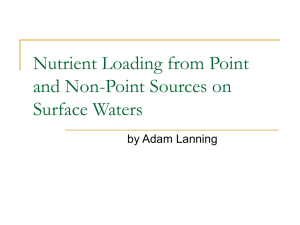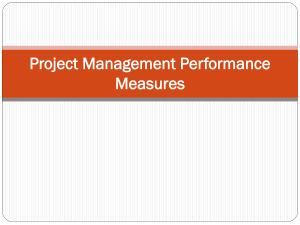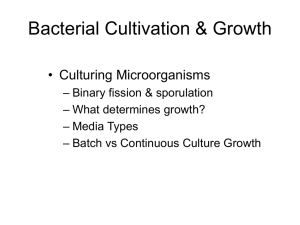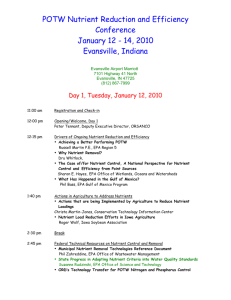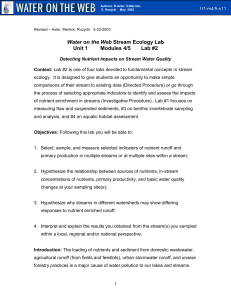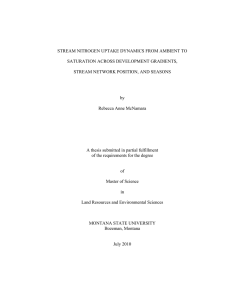Iowa Nutrient Load Estimations for Point and Non
advertisement
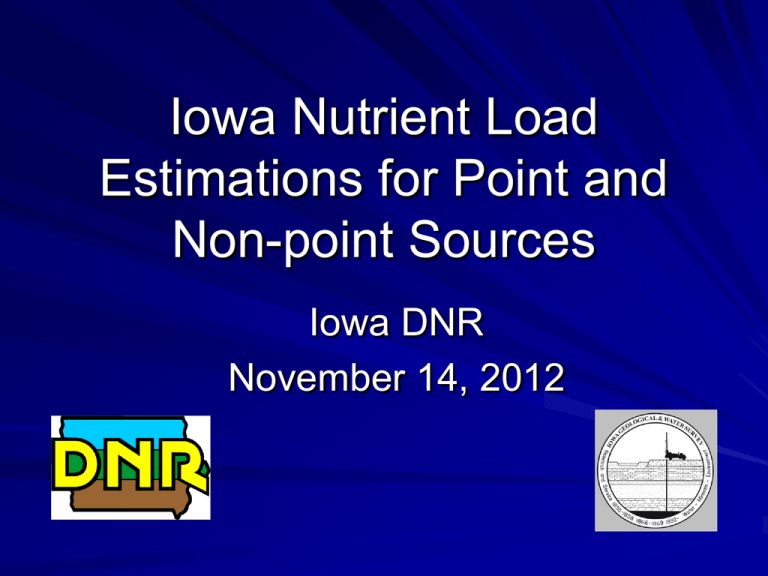
Iowa Nutrient Load Estimations for Point and Non-point Sources Iowa DNR November 14, 2012 DNR Staff Jackie Gautsch, Watershed Monitoring Rick Langel, Watershed Monitoring Mary Skopec, Watershed Monitoring Keith Schilling, Geology and Groundwater Steve Williams, Wastewater Adam Schnieders, Wastewater Calvin Wolter, GIS Iowa’s Ambient Monitoring Network 98 Sites throughout State Includes Sites Upstream and Downstream of Urban Centers Monitored monthly Mostly paired with USGS Gage locations Data from 2000-2010 Stream Load Estimation Methods AutoBeale, Pete Richards, 1998 Load Estimator (LoadEst), Rob Runkel, USGS, 2004 Mean Value AutoBeale Method Method that uses a ratio of load to flow to estimate missing data Data for 2003 Nutrient Budget Data from 2000-2002 71 Sites LoadEst Method Method that uses a regression model incorporating flow and time to estimate missing data Data from 2000-2010 77 sites estimated Mean Value Data from 2000-2010 Mean value for NO3-N and Total P from all samples Mean flow rate from USGS gages 77 sites evaluated Check for Unreasonable LoadEst Values More than +/- 15% of Mean Value loads Residual error more than +/- 2.0 Error ratio > 10 NO3-N concentration > 25 ppm Total P concentration > 10 ppm Check hydrograph vs. sample date to see if full range of flows sampled Final Load Estimates Use acceptable LoadEst models (59 for Nitrate, 51 for Total P), AutoBeale models (71) Mean Value models (77) Average of all models available (77 sites) Total N and P Loads Sum up loads for 24 outer basins Total N = NO3-N/0.82 Sum area of outer basins (83% of state) Scale up to State area Stream load Tons/yr Nutrient Yield Lbs/ac Total N 280,000 16.0 Total P 13,800 0.77 Point Source Load Calculation For 102 Major Municipal and 28 Industrial Facilities Load = Flow * Concentration Use Average Annual Flow = 2/3 Wet Weather Design Flow Use 25 ppm N and 4 ppm P in discharge from “Wastewater Engineering” Metcalf & Eddy Non-point Source Calculation Total State Load minus Point Source Load Total stream load NPDES load Non-point source load Tons N/yr 280,000 18,300 (6.5%) 261,700 (93.5%) Tons P/yr 13,800 2,900 (21%) 10,900 (79%) Point Source Biological Nutrient Removal For 102 Municipal and 28 Industrial Major facilities Assume concentration reduction for TN from 25 mg/l to 10 mg/l Assume concentration reduction for TP from 4 mg/l to 1 mg/l Use Average Annual Flow = 2/3 Wet Weather Design Flow Point Source Biological Nutrient Removal Total N Point source reduction = 11,000 tons/year (4% of Total N stream load) Total P Point source reduction = 2,170 tons/year (16% of Total P stream load) Non-point Source Reduction needed to meet 45% goal Non-point Source TN reduction needed = 45%-4% = 41% or 115,000 tons Total N Non-point Source TP reduction needed = 45%-16% = 29% or 4,040 tons Total P Summary Stream load estimation process could be improved by tailoring the monitoring schedule to better meet the needs of load estimation programs Point source load estimations could be improved by requiring nutrient sampling and obtaining flow data


